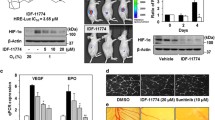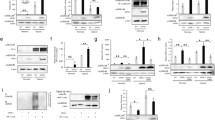Abstract
Purpose
The cytoprotective mechanism of amifostine (WR-2721) implies free radical scavenging and DNA repair activities. We investigated additional cytoprotective pathways involving intracellular hypoxia and the activation of the hypoxia-inducible factor (HIF) pathway, a key transcription factor regulating glycolysis, angiogenesis and apoptosis, which is also linked with radioresistance.
Materials and methods
The glucose and oxygen levels in the peripheral blood of patients receiving 1000 mg amifostine were determined at various time-points in order to investigate the metabolic changes induced by amifostine. MDA468 breast tumor cell lines were incubated with a high amifostine concentration (10 mM) to overcome the natural resistance of cancer cells to influx of the non-hydrolyzed WR-2721, and the HIF1α protein levels were determined by Western blot analysis. In vivo experiments with Wistar rats were performed in order to assess immunohistochemically changes in the intracellular accumulation of HIF1α induced by amifostine (200 mg/kg).
Results
By 30 min following amifostine administration, the hemoglobin oxygen saturation and pO2 levels had increased in the peripheral blood while glucose levels had reduced, providing evidence that normal tissue metabolism switches to glycolytic pathways. Incubation of cell lines with amifostine resulted in HIF1α induction. In Wistar rats administration of amifostine resulted in increased HIF1α accumulation in normal tissues.
Conclusions
Since it is doubtful whether dephosphorylation of amifostine to the active metabolite WR-1065 occurs within tumoral tissues (an acidic environment that lacks vascular alkaline phosphatase activity), intracellular hypoxia and upregulation of HIF1α represents an additional, normal tissue-specific, amifostine cytoprotective pathway.




Similar content being viewed by others
References
Grdina DJ, Sigdestad CP (1989) Radiation protectors: the unexpected benefits. Drug Metab Rev 20:13–42
Holwitt EA, Koda E, Swenberg CE (1990) Enhancement of topoisomerase I-mediated unwinding of supercoiled DNA by the radioprotector WR-33278. Radiat Res 124:107–109
Shen H, Chen ZJ, Zilfou JT, Hopper E, Murphy M, Tew KD (2001) Binding of the aminothiol WR-1065 to transcription factors influences cellular response to anticancer drugs. J Pharmacol Exp Ther 297:1067–1073
Grdina DJ, Murley JS, Kataoka Y, Calvin DP (2002) Differential activation of nuclear transcription factor kappaB, gene expression, and proteins by amifostine’s free thiol in human microvascular endothelial and glioma cells. Semin Radiat Oncol 12 [Suppl 1]:103–111
Purdie JW, Inhaber ER (1983) Interaction of cultured mammalian cells with WR-2721 and its thiol, WR-1065: implications for mechanisms of radioprotection. Int J Radiat Biol 43:517–527
Glover D, Negendank W, Delivoria-Papadopoulos M, Glick JH (1984) Alterations in oxygen transport following WR-2721. Int J Radiat Oncol Biol Phys 10:1565–1568
Allalunis-Turner MJ, Walden TL Jr, Sawich C (1989) Induction of marrow hypoxia by radioprotective agents. Radiat Res 118:581–586
Koukourakis MI, Giatromanolaki A, Kouroussis C, Kakolyris S, Sivridis E, Frangiadaki C, Retalis G, Georgoulias V (2002) Hypofractionated and accelerated radiotherapy with cytoprotection (HypoARC): a short, safe and effective postoperative regimen for high-risk breast cancer patients. Int J Radiat Oncol Biol Phys 52:144–155
Koukourakis MI, Yannakakis D (2001) High dose daily amifostine and hypofractionated intensively accelerated radiotherapy for locally advanced breast cancer. A phase I/II study and report of early and late sequelae. Anticancer Res 21:2973–2978
Semenza GL (1998) Hypoxia-inducible factor 1: master regulator of O2 homeostasis. Curr Opin Genet Dev 8:588–594
Huang LE, Gu J, Schau M, Bunn HF (1998) Regulation of hypoxia-inducible factor 1α is mediated by an O2-dependent degradation domain via the ubiquitin-proteasome pathway. Proc Natl Acad Sci U S A 95:7987–7992
Huang E, Arany Z, Livingston DM, Bunn F (1996) Activation of hypoxia-inducible transcription factor depends primarily upon redox-sensitive stabilization of its α subunit. J Biol Chem 271:32253–32259
Ema M, Hirota K, Mimura J, Abe, H, Yodoi J, Sogawa K, Poellinger, Fujii-Kuruyama Y (1999) Molecular mechanisms of transcription activation by HLF and HIF1a in response to hypoxia: their stabilization and redox signal-induced interaction with CBP/p300. EMBO J 18:1905–1914
Yuhas JM (1980) Active versus passive absorption kinetics as the basis for selective protection of normal tissue by S-2-3-aminopropylamino-ethylphosphorothioic acid. Cancer Res 40:1519–1524
Okino ST, Chichester CH, Whitlock JP Jr (1998) Hypoxia-inducible mammalian gene expression analyzed in vivo at a TATA-driven promoter and at an initiator-driven promoter. J Biol Chem 273:23837–23843
Chen C, Pore N, Behrooz A, Ismail-Beigi F, Maity A (2001) Regulation of glut1 mRNA by hypoxia-inducible factor-1. Interaction between H-ras and hypoxia. J Biol Chem 276:9519–9525
Semenza GL, Roth PH, Fang HM, Wang GL (1994) Transcriptional regulation of genes encoding glycolytic enzymes by hypoxia-inducible factor 1. J Biol Chem 269:23757–23763
Akakura N, Kobayashi M, Horiuchi I, Suzuki A, Wang J, Chen J, Niizeki H, Kawamura K, Hosokawa M, Asaka M (2001) Constitutive expression of hypoxia-inducible factor-1alpha renders pancreatic cancer cells resistant to apoptosis induced by hypoxia and nutrient deprivation. Cancer Res 61:6548–6554
Piret JP, Mottet D, Raes M, Michiels C (2002) CoCl2, a chemical inducer of hypoxia-inducible factor-1, and hypoxia reduce apoptotic cell death in hepatoma cell line HepG2. Ann N Y Acad Sci 973:443–447
Geng L, Donnelly E, McMahon G, Lin PC, Sierra-Rivera E, Oshinkan H, Hallahan DE (2001) Inhibition of vascular endothelial growth factor receptor signaling leads to reversal of tumor resistance to radiotherapy. Cancer Res 6:2413–2419
Gorski DH, Beckett MA, Jaskowiak NT, Calvin DP, Mauceri HJ, Salloum RM, Seetharam S, Koons A, Hari DM, Kufe DW, Weichselbaum RR (1999) Blockage of the vascular endothelial growth factor stress response increases the antitumor effects of ionizing radiation. Cancer Res 59:3374–3378
Lee HS, Park HJ, Lyons JC, Griffin RJ, Auger EA, Song CW (1997) Radiation-induced apoptosis in different pH environments in vitro. Int J Radiat Oncol Biol Phys 38:1079–1087
Park HJ, Lee SH, Chung H, Rhee YH, Lim BU, Ha SW, Griffin RJ, Lee HS, Song CW, Choi EK (2003) Influence of environmental pH on G(2)-phase arrest caused by ionizing radiation. Radiat Res 159:86–93
Brizel DM, Schroeder T, Scher RL, Walenta S, Clough RW, Dewhirst MW, Mueller-Klieser W (2001) Elevated tumor lactate concentrations predict for an increased risk of metastases in head-and-neck cancer. Int J Radiat Oncol Biol Phys 51:349–353
Koukourakis MI (2002) Amifostine in clinical oncology: current use and future applications. Anticancer Drugs 13:181–209
Zhong H, De Marzo AM, Laughner E, Lim M, Hilton DA, Zagzag D, Buechler P, Isaacs WB, Semenza GL, Simons JW (1999) Overexpression of hypoxia-inducible factor 1a in common human cancers and their metastases. Cancer Res 59:5830–5835
Talks KL, Turley H, Gatter KC, Maxwell PH, Pugh CW, Ratcliffe PJ, Harris AL (2000) The expression and distribution of the hypoxia inducible factors HIF-1a and HIF-2a in normal human tissues, cancers and tumor associated macrophages. Am J Pathol 157:411–421
Giatromanolaki A, Koukourakis MI, Sivridis E, Turley H, Talks K, Pezzella F, Gatter KC, Harris AL (2001) Relation of hypoxia inducible factor 1 alpha and 2 alpha in operable non-small cell lung cancer to angiogenic/molecular profile of tumours and survival. Br J Cancer 85:881–890
Vukovic V, Haugland HK, Nicklee T, Morrison AJ, Hedley DW (2001) Hypoxia-inducible factor-1alpha is an intrinsic marker for hypoxia in cervical cancer xenografts. Cancer Res 61:7394–7398
Aebersold DM, Burri P, Beer KT, Laissue J, Djonov V, Greiner RH, Semenza GL (2001) Expression of hypoxia-inducible factor-1alpha: a novel predictive and prognostic parameter in the radiotherapy of oropharyngeal cancer. Cancer Res 61:2911–2916
Koukourakis MI, Giatromanolaki A, Skarlatos J Corti L, Blandamura S, Piazza M, Gatter KC, Harris AL (2001) Hypoxia inducible factor HIF-1a and HIF-2a expression in early esophageal cancer and response to photodynamic therapy and radiotherapy. Cancer Res 61:1830–1832
Koukourakis MI, Giatromanolaki A, Sivridis E, Simopoulos C, Turley H, Talks K, Gatter KC, Harris AL (2002) Hypoxia-inducible factor (HIF1A and HIF2A), angiogenesis, and chemoradiotherapy outcome of squamous cell head-and-neck cancer. Int J Radiat Oncol Biol Phys 53:1192–1202
Lu H, Forbes RA, Verma A (2002) Hypoxia-inducible factor 1 activation by aerobic glycolysis implicates the Warburg effect in carcinogenesis. J Biol Chem 277:23111–23115
Semenza GL (2001) Hypoxia-inducible factor 1: oxygen homeostasis and disease pathophysiology. Trends Mol Med 7:345–350
Author information
Authors and Affiliations
Corresponding author
Additional information
This work is presented on behalf of the Tumour and Angiogenesis Research Group.
Rights and permissions
About this article
Cite this article
Koukourakis, M.I., Giatromanolaki, A., Chong, W. et al. Amifostine induces anaerobic metabolism and hypoxia-inducible factor 1α. Cancer Chemother Pharmacol 53, 8–14 (2004). https://doi.org/10.1007/s00280-003-0691-z
Received:
Accepted:
Published:
Issue Date:
DOI: https://doi.org/10.1007/s00280-003-0691-z




